|
Africa
2024 Journal Pages:
1
2
3
4
5
6
7
8
9
10
11
12
January
10 - continued
We
stopped to watch a mixed herd of zebras and wildebeest; they were
hanging out in the shade together. The wildebeests had some very
young babies, their light brown coats in contrast with the darker
adults. There was also a really small baby zebra in the group, his
slightly brownish striped coat still fuzzy with his baby fur. We
again commented on the fact that all of the animals we were seeing
were in very good condition, sleek and fat from the good grazing.
A
bit further on we came to a tree overlooking a waterhole, and in
the shade of it there lay four lionesses. They were resting, but
alert, ready to hunt if the opportunity should arise. One of them
stared at us fixedly, while another yawned widely and then started
licking her paws. The lionesses, with their refined features and
intent expressions, seem more elegant than the male lions.
We stopped for tea at the same large waterhole as we had
the day before. A brown snake eagle sat high in a tree, no doubt
searching for brown snakes to eat. There were a variety of birds
all around us; a few of the new ones included the common green
shank and a village indigo. Several bull elephants came down to
the water, and we watched as they sucked up trunkfulls of mud and
water to spray over themselves for a nice cooling mud bath. It was
very peaceful, though there was a little excitement when Janell
got ants in her pants.
We returned to camp around noon for lunch. In the afternoon
we packed up our belongings to be ready to move to a new camp the
next day. We had a bit of extra time to rest, but it was too hot
to stay inside the tents. To my delight, Gee showed up at my tent
with my lost suitcase! It had arrived in Maun the previous day,
and Gee had arranged for one of his friends to pick it up at the
airport and drive it as far as the buffalo fence, where More met
him and brought the suitcase back to camp. It was nice to be
reunited with my clothes, but more importantly, Duma was safe and
with us once again! I was very relieved, and I am sure Duma was
also.
|

Duma!
|
We had high tea at four o'clock, and then went back out for
an afternoon drive. Again we spent some time with the zebras. We
noticed many of them had fainter brownish stripes between each
black stripe; these are called shadow stripes. The white stripes
on several of the zebras were a dusty brown; Gee told us this was
a genetic trait. I was surprised; I had always thought they were
just dirty. I love the way Gee pronounces ‘zebra’ the British
way, with a short E sound (rhymes with Debra).
|
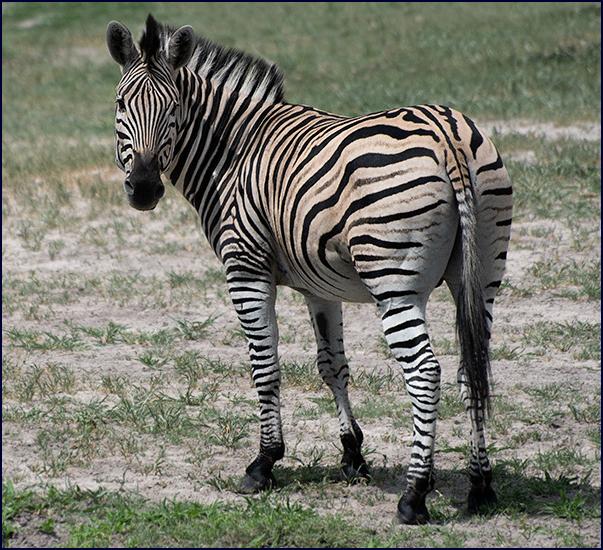
Shadow stripes
|
We drove through an area where the trees had been killed by
flooding; seismic shifts periodically change which areas are
covered when the Delta floods. It was an eerie skeleton forest,
with large bare trunks standing tall, their dead limbs reaching
out toward us like grasping hands.
We could see dark clouds and
storms around the horizon, and again we noticed the weird
phenomenon of lightning without thunder; we surmised that because
the land was so flat we could see the lightning from much further
away than we would at home - too far to hear the thunder.
A few zebras and a lone elephant wandered
among the dead trees, and we saw a pair of tiny steenboks. Guinea
fowl scurried through the brush, and two black-backed jackals
passed by like ghosts in the fading light.
We stopped for sundowners at the waterhole.
‘Sundowners’ is a delightful African tradition of pausing
somewhere with a beautiful view to watch the sun go down while
having an adult beverage. Gee had brought a bottle of pink bubbly
at Janell’s request, along with wine and gin and tonics for the
rest of us. We stretched our legs and admired the view. The sky
was filled with dramatic clouds, backlit by the setting sun.
It was getting quite dark by the time we arrived back at
camp. We had just gotten out of the land cruiser and headed to our
tents when the lady from the game reserve’s office walked in to
our camp to tell us that there was a pride of lions moving down
the road! We jumped back in the vehicle and Gee took us to find
them.
|
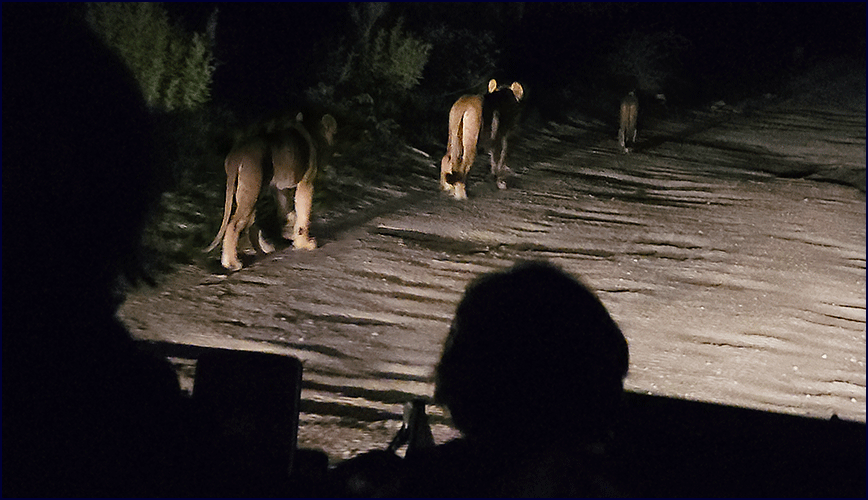
Night lions
|
There were lion tracks everywhere! Gee read the spoor, and
soon caught up with the pride. Sixteen lions were strolling down
the road in a strung out line, mostly lionesses with their half
grown cubs - the Kaziikini Pride. We tailed behind them, and they
totally ignored us. We followed them for a while, and then left
them to their night hunt and headed back to camp for dinner. The
thing that really amazed us was the fact that the lady from the
office had walked over
to tell us about the lions; we didn’t think it seemed wise to be
walking through the dark bush with so many lions close by, and Gee
agreed.
Mosa
announced another great meal, telling us each course amid murmurs
of yep, yep, yep in what we came to realize was his signature
style. Over dinner and
a glass of wine, we reviewed our favorite sightings of the day -
no question about it, for me it was the wild dog hunt.
I
heard the inquisitive whoop, whoop of a lone hyena during the
night. In the wee hours I heard a series of low booming calls I
couldn’t identify; Gee told us in the morning it was the call of
ground hornbills.
January 11
Moving day! We were heading for
our next camp, near Dombo Pools in the Moremi Game Reserve, in the
Okavango Delta. The seasonal rains from Angola, hundreds of miles
to the north, travel down the river into the midst of the Kalahari
Desert, flooding a vast inland river delta. It seems a little
incongruous that the Okavango Delta is flooded during the dry
season, and the waterways are empty during the rains.
We were up at five again,
and the guys were taking down our tents while we had breakfast.
Gee would take us on an all-day drive today, giving the camp staff
time to finish dismantling the camp, move it to the new location,
and then get it all set up before we arrive in the evening.
On the road before six, we saw most of the regulars;
impala, warthogs, zebras, steenboks, some distant giraffes.
|
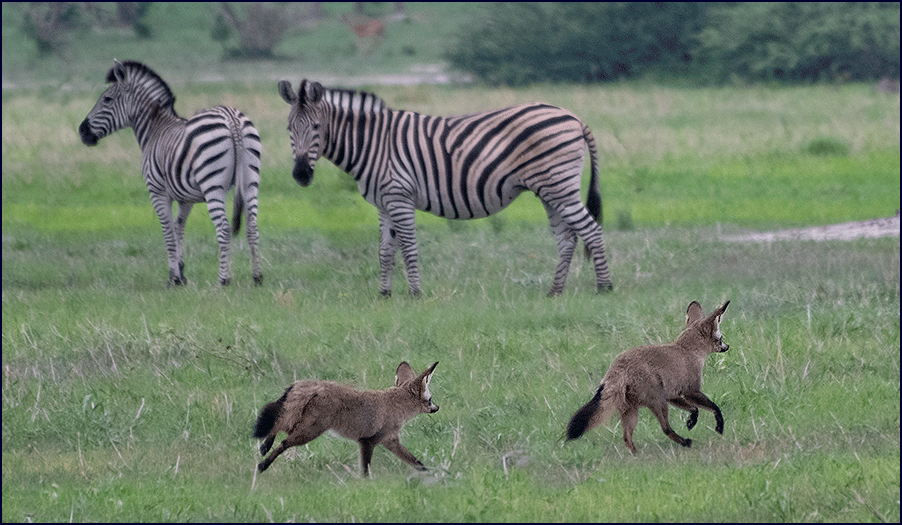
Bat-eared foxes
|
As
we passed the waterhole where we had sundowners the night before,
to our delight we found a pair of bat-eared foxes. These small
foxes are brown with black legs and tail, and they have a dark
mask around their eyes. They have the most enormous ears, for
which they are named. Very shy, they ran off as we approached,
crossing in front of the zebras. I was surprised they were here; I
had seen bat-eared foxes in the Kalahari Desert in the past, but I
did not know they lived so close to the Delta.
There were quite a few giraffes around this morning - I never tire
of seeing them. One big male was feeding on a tree close to the
road, and we spent some time watching him eat. An oxpecker sat on
his head, pecking relentlessly at his knobby horns.
An impala buck stood up on a termite mound, and we had a
nice encounter with an elephant that was right by the road. A
Wahlberg’s eagle sat high in a dead tree. We watched a beautiful
yellow bird with a black face working on a hanging nest; it was a
masked weaver. A
red-billed francolin perched on a tree and posed for us; we saw
these plentiful birds on nearly every game drive, but this was the
best photo op of one we’d had.
|
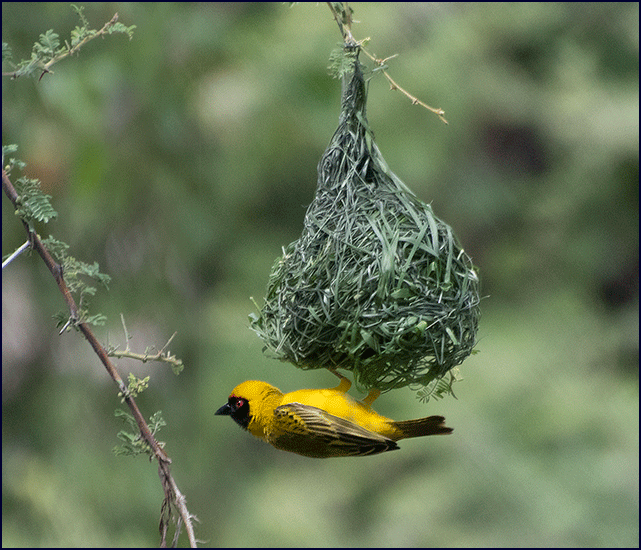
Masked Weaver
|
A little dark brown head peaked out of a hole in an old
termite mound; it was a mother dwarf mongoose. She was soon
followed by three or four youngsters. These tiny mongoose look a
little like a weasel or a mink, though they are not actually
related. The mongoose mother peered at us curiously, but the rest
of her family scurried about unconcerned.
We had not realized how huge the Kaziikini Reserve is until
we were leaving it; we had been driving straight for hours now,
and we were surprised to learn we were still in Kaziikini. Gee
said that it encompasses over 60,000 hectares (nearly 150,000
acres), and stretches all the way from near the buffalo fence to
the South Gate of Moremi.
We came upon a troop of olive baboons. I always have
slightly mixed feelings about the baboons; they are fascinating to
watch, but at the same time mildly disturbing. Baboons are
intelligent and interesting, and have an athletic loose-limbed
grace to how they move. The babies are cute; they have red faces
when they are newborn, which soon turn pink, and eventually grey
as the get older. But the young baboons definitely become less
cute as they mature; the adults tend to have sullen or belligerent
expressions, and singularly unattractive bald butts. I think what
really disturbs me about them as they seem just a little too
human.
|
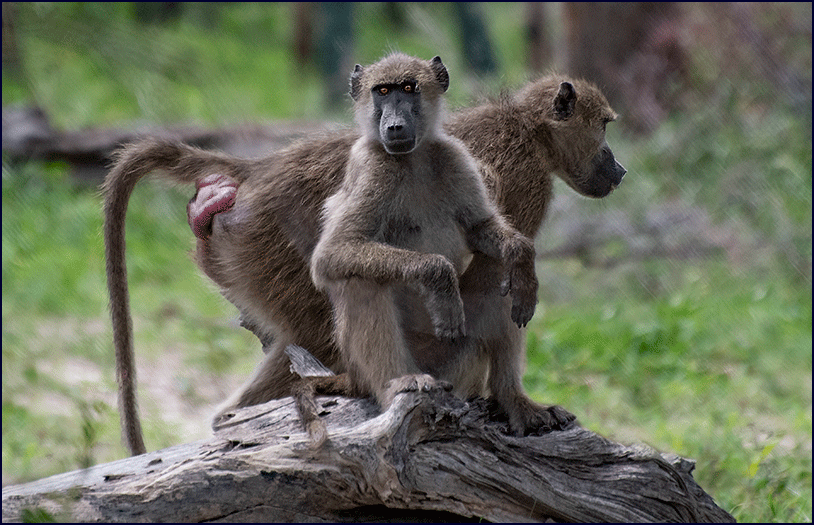
Olive baboons
|
A group of
banded mongooses were sticking close to the baboons. They are much
larger than their dwarf cousins, and have subtle striping on their
bodies. One mongoose sat up in a tree (which I didn’t know they
could do), and the others on the ground stood up on their hind
legs and gazed at us, like meerkats on the lookout. Gee told us
that baboons and mongoose hang out together and each act as a
warning system to the other.
|
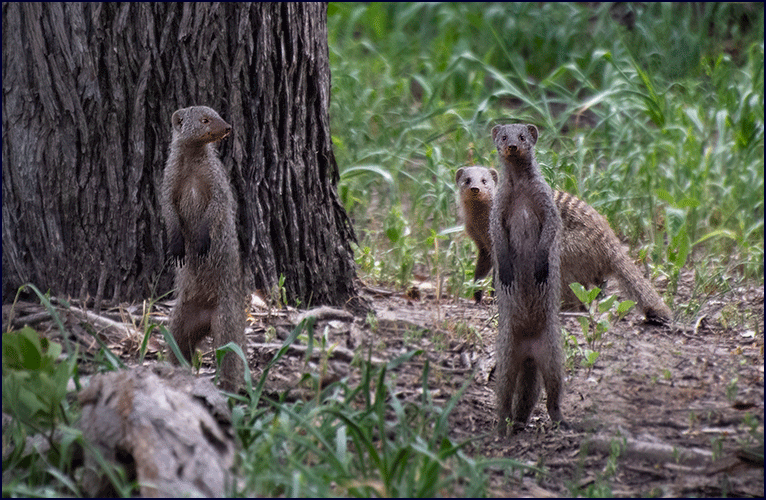
Banded mongooses |
We came to the South Gate of Moremi, and
after pausing to sign in, we entered the park and drove through
some beautiful forest. A
female kudu was lying in a shady spot under the trees, along with
two half grown youngsters.
|
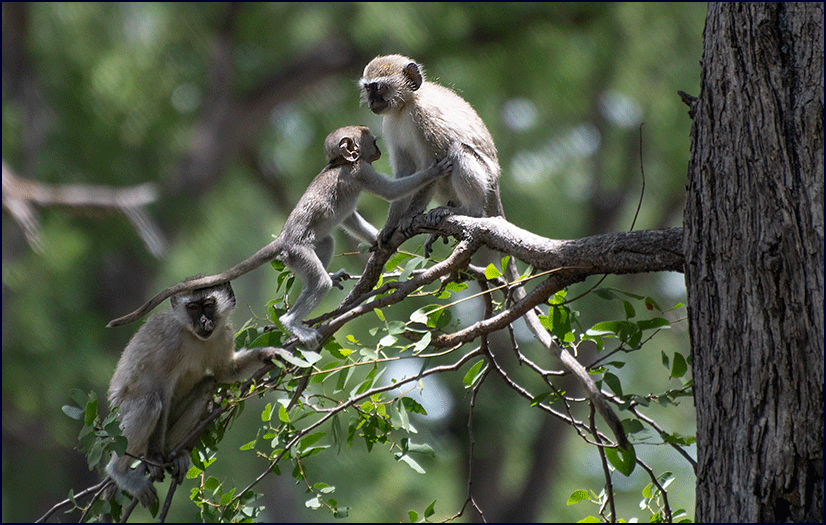
Vervet monkeys
|
A troop of vervet monkeys moved through the trees; we sat for a
long while watching the young ones playing. They would scurry up a
treetrunk, climb out onto a branch, dangle from a vine and wrestle
with each other a bit, launch themselves head first into the air
and plummet to the ground – and then it was back up the tree to
start the whole thing over again. I have never been a fan of
monkeys in captivity, but I love watching them in the wild where
they belong.
The
landscape changed now that we were in the Okavango Delta. We
followed the Khwai River as it wound its way through the broad
floodplains. Many areas were thick with tall grass and reeds, and
small rain-fed waterholes were everywhere. Gee pointed out some
lovely flowers, the petals bright red, fringed in yellow - these
were flame lilies, and they are very beautiful but also quite
poisonous. A tiny zitting cisticola serenaded us from where he
perched on a stalk of tall marsh grass.
|
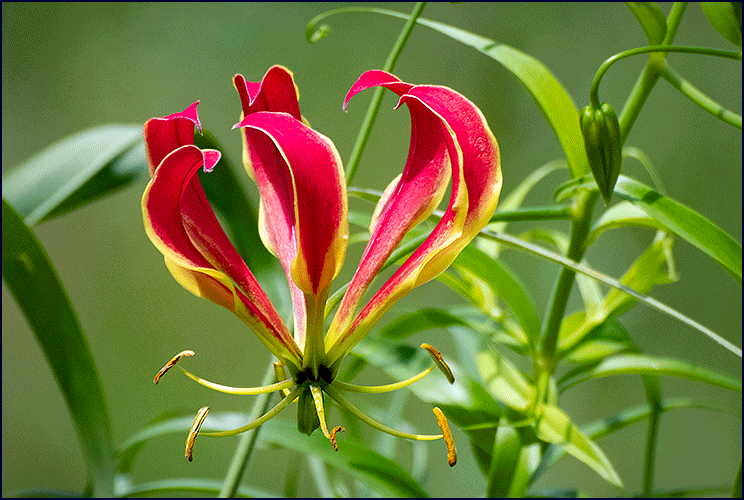
Flame lilly
|
As the landscape changed, so did the
wildlife. It was early afternoon when we paused by the river.
Suddenly a hippopotamus stood up out of the water,
the first we had seen on this trip. He looked at us for a moment
and then sank back down to submerge in the water. We saw more
hippos as we followed the river course. I told a few bad hippo
jokes:
What
do you call a hippopotamus who talks badly about his friends?
A hippo-crit
What
do you call a hippo who always thinks she’s sick?
A hippo-chondriac.
What
do you call a one-legged hippo?
A
hoppo.
We had our first sight of red lechwes, an antelope that is
at home in the Delta. Similar in size to an impala, these reddish
brown antelopes are well adapted to the wetlands; they love the
swampy areas, and run into the shallow water to escape predators.
Their front legs are shorter than their hind, giving them a very
downhill appearance. They have webbed feet that help them run
through the water, and are athletic runners and jumpers. The herd
took off when we approached, but stopped once they had put a bit
of distance between us. We watched as a very small baby nursed on
his mother. Gee told us the lechwes live almost exclusively in the
Okavango Delta; they are prevalent here, but there are very few
elsewhere – just a few in Chobe and in Zambia.
|
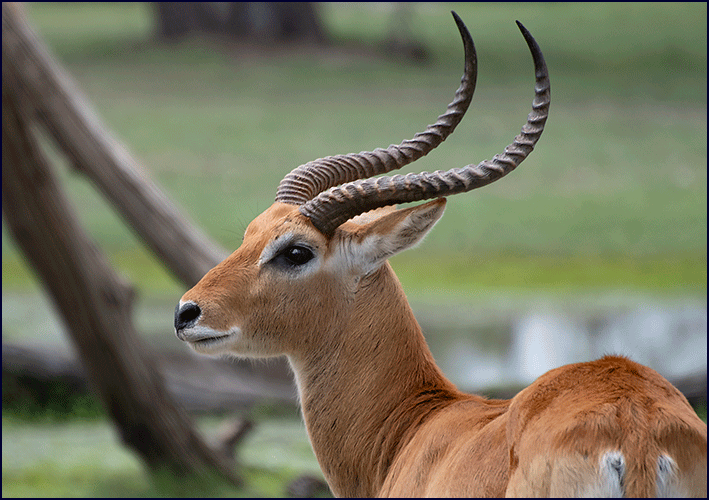
Red lechwe
|
We drove along the edge of a huge open floodplain by the
Khwai River. A saddle-billed stork stood in the tall grass; these
striking birds have black and white bodies and huge red bills with
broad stripes (or saddles) of black topped with yellow. The
females have bright yellow eyes, while the males’ eyes are dark.
This one was a female; a few minutes later we saw her mate as
well. These storks are
an endangered species, and the Okavango Delta is one of the few
places where they can still be found.
|
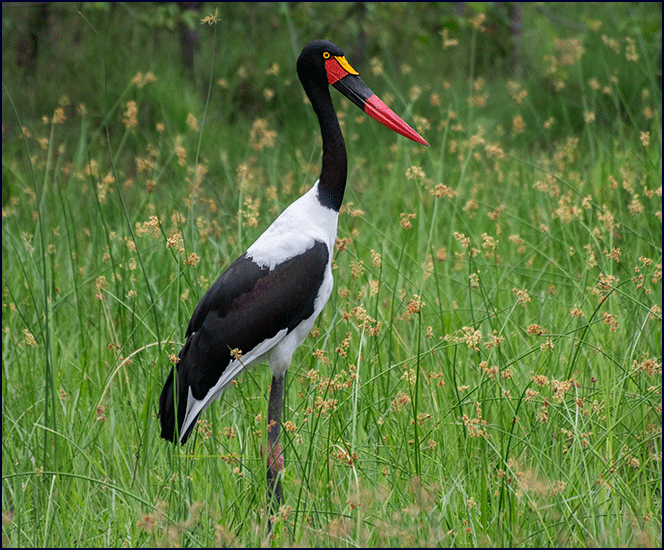
Saddle-billed stork
|
We stopped beside a large pool occupied by over a dozen
hippos. These huge animals need to be mostly in the water during
the day to stay cool and have protection from the sun, but at
night they come out to graze, and might travel up to ten
kilometers. Though considered one of the more dangerous animals in
Africa, hippos are herbivores, eating mainly grasses and plants.
But the males are very territorial, and can be aggressive -
don’t get between a hippo and the water!
One huge bull hippo seemed to be swaying
up and down, forward and back. At intervals he would raise his
head higher out of the water, and he had a rather self-satisfied
expression on his face. We suddenly realized we were witnessing
hippo sex! The bull honked and chortled in his enthusiasm, his
vocalizations sounding like demented laughter. We could barely see
his mate; she was submerged, with her face only occasionally
coming up to the surface to catch her breath. Kind of an OMGMF
moment.
As we drove on across the wetlands, we saw a variety of new
waterfowl. Pygmy geese floated in the water, and squacco herons
picked their way through the grass. We saw slaty egrets, an
African crake, a green-backed heron and a coppery-tailed coucal.
Gee said the coucal has a lovely song
Fluffy white cumulous clouds were sidelit by shafts of
afternoon sunlight, but we could see dark stormclouds gathering
around us. A huge storm was blowing up; we could see the rain
coming down on the other side of the treeline, covering the plane
in a whitish haze of precipitation. We recognized that look now:
not smoke or dust! We thought we might really get drenched so Gee
stopped and put the plastic rain flaps down, but the worst of it
passed by us.
We came upon a pair of wattled cranes. These long-legged
birds are extremely rare and very beautiful. They are black
underneath, with silvery grey backs and wings with long feathers,
and elegant white necks. They are quite shy, so we were lucky to
get close enough for a good look at them.
|
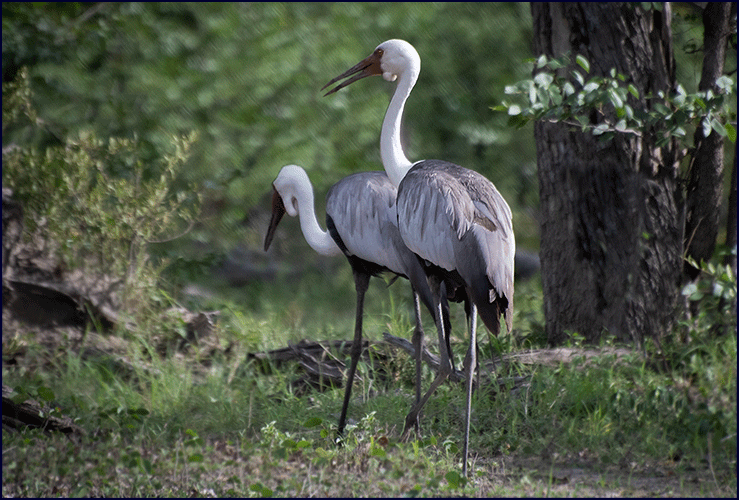
Wattled cranes
|
We passed a termite mound adorned with a set of buffalo
horns; someone had a sense of humor. There were more red lechwes
about, walking along in their ridiculously downhill way. We found
another pair of wattled cranes. Gee pointed out several village
weavers perched in the grass, attractive small yellow birds with
black faces and mottled wings. We watched an African harrier hawk
trying to raid a nest in a cavity in a dead tree; the starlings
were mobbing him to try and drive him away and protect their
nest.
We came to an area where Gee had seen cheetahs in the past,
and we stopped to scan the grasslands looking for them. Cheetahs
like wide open plains where they can see for a long ways and use
their blinding speed to run down their prey. They will often sit
up on a termite mound or stump for a better view. Cheetahs have
become quite rare, so we did not have a high expectation of seeing
them; indeed in all my trips with Gee we had only seen cheetahs
once. But we could keep hoping!
A pair of reed bucks stood
camouflaged in the brush; these antelopes look very much like the
white-tailed deer we have in Virginia, but are far less common.
They took off and ran across in front of us, while we tried to get
good action photos.
|
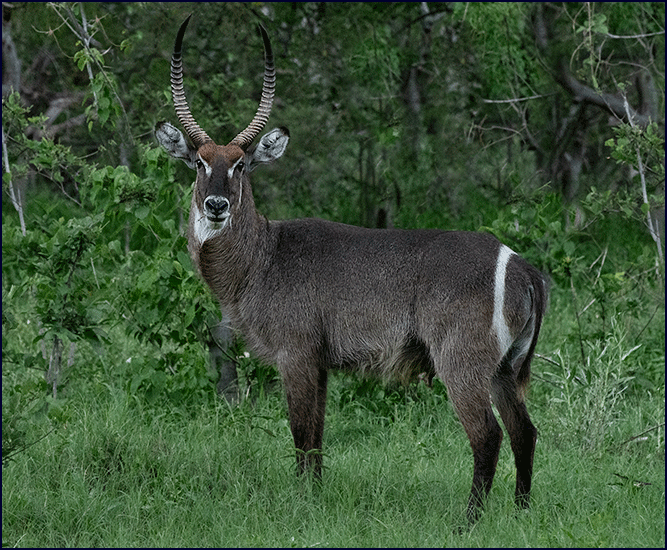
Waterbuck
|
Three female waterbucks moved through the tall grass, and a
bit further on we saw a large male. These are one of my favorite
antelopes; they are fairly large and have long soft coats, kind
faces, gentle eyes, and a white circle on their rumps like a
target. The males have
large curving ridged horns.
We
came to an open floodplain beside a strip of forest, and there we
saw a row of tents. Our Dombo Pools camp! It was beautiful. Our
tents were under the edge of the trees, with the campfire and
dining tent beside them, and a waterhole out in front.
We had only been in camp a few minutes when Gee heard the
cough-like call of a leopard; we all got back in the land cruiser
and headed out in the gathering darkness to search for it. Gee
drove slowly around the area, following the alarm calls of impalas
and birds. Soon it was pitch-dark. Gee could tell the specific
area the leopard had to be in, but we were not able to find it.
It was raining lightly so we sat in the dining tent
instead of by the campfire, discussing the day’s highlights. The
consensus was a tossup between the bat-eared foxes and hippo sex.
~
Continued
on next page ~
Africa
2024 Pages:
1
2
3
4
5
6
7
8
9
10
11
12
Back
to the AFRICA 2024 INDEX Page
|